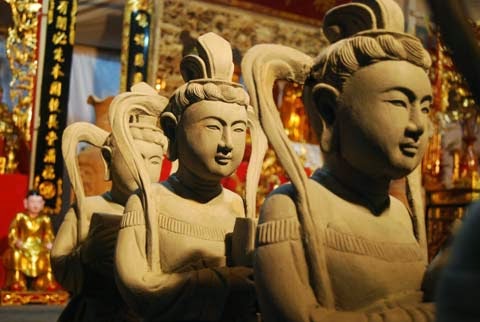The late writer Nguyen Tuan heaped praise on the skill of craftspeople in Chang Village. In his captivating story "On the peak of Tan Mount", even the god Tan Vien asked these artisans to undertake the restoration of his temple. Chang Handicraft Village is located in Son Tay near Hanoi, once the ancient capital of Thang Long. Here, wood carvers perfected techniques of overhanging and chaining sculptures. This region, in former Ha Tay province and now part of greater Hanoi, was also known for its jewelry-making, weaving and embroidery.

Wood-carving villages were founded in the Ly and Tran dynasties. They have left many breathtaking wooden sculptures, such as the Thousand Armed Thousand Eyed Buddha statue in But 'Thap Pagoda; arhat statues in Tay Phuong Pagoda; and carvings on the eaves of Dinh Bang Communal Temple. While many sculptures have been destroyed by time, turbulence and warfare, this ancient skill has not been lost. Nowadays, the villages of Son Dong, Phu Xuyen and Dong Ky are major wood carving centers, which specialize in different types of furniture and decorative items.
The most intriguing one is Son Dong Village, just 10 km from central Hanoi. Here, carvers and gilders produce ceremonial items. Watching them work one can't help but admire their skill as they wield chisels, planers and saws to accentuate the grain of the wood. Dong Son carvers produced religious items such as thrones and altars, grand inscriptions, facade boards, parallel sentences, decorative doors, cranes standing on tortoises, eight precious things, gilded boxes, etc. These items are decorated with traditional designs such as sacred animals, clouds, fire, and lotus petals. While religious items are solemn, the carpenters can include lighter, creative touches.
Hence, we can see teasing deer (symbolic of affluence) or squirrels (symbolic of thick lineage) on altars. To meet customers’ demands, carvers sometimes adapt European motifs such as leaves and grapes within a group of four sacred animals. Looking at these carvings, we can discern the cultural background and aesthetic sense of this community.

Of all chiseling techniques, overhanging sculpture is the most difficult. The carver must hollow out the back of the wooden reliefs so that a dragon's head will pop out III and phoenixes will seem to hover in the air. Chaining techniques are easier. Bas-reliefs patterns on the wood's surface are easiest type to produce.
Youngsters in Son Dong follow their relatives to master planers and saws. Every villager is knowledgeable about types of wood or how to deal with termites or wood warping.
According to Mr. Nguyen Van Tuan, a young craftsman in Son Dong, the recent economic slowdown has caused a sharp drop in demand. Some years back, every household was swamped with orders. Today, most orders come from temples, shrines and pagodas. This denotes a marked shift towards traditional and religious values in contemporary society. According to the village's carvers, the hardest thing is to capture the soul and nature of Buddhism and Holy Mother Beliefs in their creations. These artists must portray the benevolence of the Buddha, the gravity of the Holy Mother of Heaven or the Holy Mother of the Mountains, the solemnity of the arhats and Vajradhara, and the innocence of young men and maidens.
After carving, products are either gilded or polished with oil to highlight the natural wood. The most popular polish is now industrial paint. In ancient times, the use of national oil, gold and silver were widespread, and resulted in a finish that became more beautiful over time. Sadly, this old technique has been cast aside as it was time-consuming. This is unfortunate, as national oil accentuated the beauty of these incredible carvings.
Wood Carving Handicraft Village Of Vietnam.



0 comments:
Post a Comment